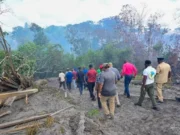During the Ministry of Natural Resources’ (MNR) Mid-Year press conference held on Wednesday, officials provided a comprehensive overview of the ministry’s oversight mechanisms for the petroleum industry. In fact, journalists were given presentations on the tools and processes used by the ministry to monitor production as well as other critical aspects of petroleum activities in Guyana.
The ministry’s Permanent Secretary, Joslyn McKenzie first highlighted the MNR’s proactive approach in ensuring collaboration with regulatory agencies and industry operators.
“As part of the ministry’s mandate, we work with our regulatory agencies and return operators to proactively monitor petroleum activities, including seismic work, drilling and production,” McKenzie stated. He highlighted the significance of the technological platforms in place, particularly the production dashboard, which allows for real-time monitoring of petroleum activities.

Trent Piaralall, co-lead of the petroleum technical team, delivered a detailed presentation on the Real-Time Production Data Dashboard.
“Myself and my colleague Marissa Foster-Gordon will be providing an overview or insight into the real time monitoring system that we have in place of that the government has access to,” he stated.
Piaralall outlined the government’s multifaceted approach to monitoring petroleum production, starting with ExxonMobil Guyana Limited’s requirement to submit facility metering designs for approval.

“Real time production monitoring is one of the many mechanisms that are in place for production oversight,” he said. Piaralall noted that the Guyana National Bureau of Standards (GNBS) is responsible for calibrating fiscal meters according to API standards.
Additionally, terminal operators manage crude lifting entitlements, ensuring that all requisite procedures are followed when tankers approach Floating Production Storage and Offloading (FPSO) vessels for offloading.
“The fourth one I have here is the GNBS presence on each FPSO during offloading,” Piaralall stated.
Adding that third-party inspections are conducted alongside GNBS as an added layer of protection, he said, “We also have third party inspection during offloading, so you might ask why third-party inspection when you also have GNBS but the third-party inspection is very important…”
He also pointed out that the ministry leverages the Maxar software, a satellite imagery tool, which is also accessible to the Environmental Protection Agency (EPA), to monitor offshore activities, particularly potential spills. The Maritime Administration Department (MARAD) oversees vessel movements within Guyana’s waters, especially tankers entering for offloading, while captains of cargo tankers are responsible for verifying the correct volume of oil loaded onto their vessels.
Piaralall further explained that the Guyana Revenue Authority (GRA) plays a crucial role in authorizing all activities related to the FPSOs. “Anything entering or leaving those FPSOs requires GRA’s authorization,” he noted.
In addition, he said the MNR team is also engaged in weekly and monthly meetings with operators, where they review daily and monthly production reports.
Another mechanism mentioned is the ministry’s monitoring capabilities through the installation of a fiber optic cable for real-time production monitoring, a project initiated by ExxonMobil. Piaralall noted that the government granted approval for this project on the condition that it would have real-time access to the data transmitted via the cable. This real-time monitoring has been in effect since February 2022 for the Liza 1 field, and was later connected to Liza 2 and Payara developments.
As future projects like Yellowtail, Uaru, and Whiptail come online, they too will be integrated into the real-time monitoring system, the MNR official stated. Notably, data from each FPSO is transmitted from offshore to onshore via the fiber optic cable and stored in a cloud-based system, updating automatically on the dashboard every 10 minutes.
Piaralall noted that the government has the authority to request adjustments, either increasing or decreasing the amount of real-time data available on these platforms.
To this end, PS McKenzie emphasised the layered approach to oversight by adding the third-party inspector. “The third-party inspector is another layer that is also recruited by each lifter including the government so notwithstanding the fact that we have GRA and GNBS, we also hire an international third party for every single lift…” he added.
Moreover, Marissa Foster-Gordon, another co-lead of the petroleum technical team, presented on the government’s data dashboard, which features tabs for various monitoring categories, including production data, tank inventory, gas management, flare management, produced water and more.
“[We] are able to access each tab which gives us different information,” Foster-Gordon said. She explained that by just a click on a tab ,the government can access information on the three FPSOs that are currently producing oil offshore Guyana.
She added, “The produce water [tab] monitors the equipment stats for that is responsible for processing the produced water from the facilities and the volume of treated and discharged produced water as well.”
Additionally, the production data tab, in particular, displays oil and gas production volumes from the respective wells and the operational status of major equipment like gas compressors and oil separators. “At the bottom of the production data dashboard, it gives you the previous day’s information, including all reported pressures and temperatures,” Foster-Gordon added.













